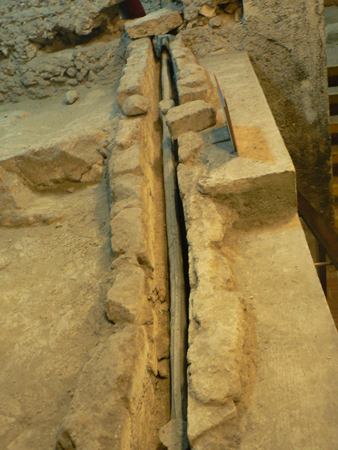Lead analysis of Ancient Naples’ harbour reveals impact of Mount Vesuvius eruption AD79 on water supply
Published: 20 May 2016
An international research team has uncovered new evidence that the great volcanic eruption of Mount Vesuvius in AD 79 disrupted the water supply of cities around the Bay of Naples.
An international research team has uncovered new evidence that the great volcanic eruption of Mount Vesuvius in AD 79 disrupted the water supply of cities around the Bay of Naples.
Geochemists and geoarchaeologists at the University of Lyon, University of Glasgow and Soprintendenza Archeologica di Napoli analysed lead isotopes from sediment cores taken from the harbour and mineral deposits from ancient Naples’ water supply system. The use of Pb isotopes shows that the volcanic catastrophe of nearly 2,000 years ago not only destroyed the urban lead pipe water supply network of these ancient cities, but also that it took the Roman administration several decades to replace it.
Their paper, published by Proceedings of the National Academy of Sciences, shows that lead pollution in Naples' harbour from the city's lead pipe water distribution network is a sensitive indicator of urbanization in the city; it traces the damage to, repair and expansion of the network beset by invasions and volcanic eruptions
Analysis of core sediments from the harbour allowed the team to trace lead contamination through the centuries. The team suggest that the volcanic eruption may have deformed the slope of the channel delivering water and/or that fine volcanic ash may have clogged the system. The isotopic composition of lead deposits in the Naples harbour show a sharp change before and after the AD79 eruption of Vesuvius, showing that the old pipes were replaced with new ones from a different mix of sources.
Dr Duncan Keenan-Jones, a research associate in Classics in the University of Glasgow’s School of Humanities, collected the travertine (mineral deposit) samples from the ancient water systems which helped identify these systems as the source of the lead in the harbour. He worked on the interpretation and integration of the travertine and harbour sediment analyses and provided archaeological and historical information on Naples and its surrounds, including on the water systems in the area.
He said: “It’s clear that focused efforts of the Roman administration resulted in the complete restoration of the water system in this part of the city, but the same cannot be said for later periods. One of the exciting findings of this paper is that we can trace the expansion and contraction of the water system - a barometer of the prosperity of the city - through the amount of imported lead from water pipes showing up in the harbour deposits.
“The water system reached a peak in the 5th century, when the next major eruption of Vesuvius, invasions and a plague dealt the city a major blow. This time, repairs were not as comprehensive, nor were they following the Gothic Wars in the mid-6th century. This method should be applicable in many other ancient cities in the Western half of the Roman Empire, where urban lead pipe water systems were very common.”
Media enquiries: liz.buie@glasgow.ac.uk / 0141 330 2702
First published: 20 May 2016
<< May

